As we approached the abandoned lighthouse that stands on a manmade rockpile along the western edge of the thoroughfare leading into New York Harbor, our boat was lifted by a large swell. Solid eight footers broke on the rocks creating a profusion of white water that cascaded around the back side and down the jetty rocks that, in bygone days, protected the lightkeeper’s boat. The conditions were ideal for striped bass and bluefish to use to their advantage when hunting. The closer we got, the more excited we became about casting into the swirling maelstrom because we knew the fish would be there.
Anglers on two other boats had the same idea, but the wind, waves and current hampered their ability to hold position near the rocks. They ran their boats close enough for a quick cast but were quickly swept away. Even when the operator tried to hold the boat in position for an angler to cast, their attempts were short lived. Conditions like these can make fishing good structure nearly impossible. We held back and watch the other boats make several attempts only to drift out of range almost as soon as they got into position. The frustration on the faces of the operators was evident, especially when we pulled into casting range and used our secret weapon—the Helm Master® EX system our Yamaha-powered Pathfinder® 2700 installed at the Maverick® Boat Group factory in Fort Pierce, Florida.
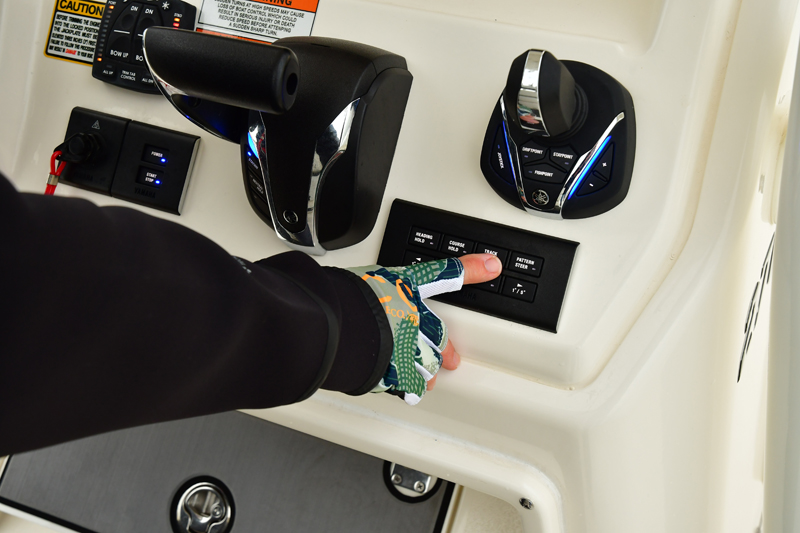
If you’re not familiar with Yamaha’s remarkable Helm Master EX system, you should be, especially if you’re thinking about a new boat or repowering an existing boat. It’s quite literally artificial intelligence for your boat, and a game changer for fishermen.
The complete Helm Master EX boat control system consists of electronic steering, shift and throttle binnacle, joystick, autopilot, GPS receiver, heading sensor, CPU and touchscreen multifunction display all interfaced into a seamless operating environment that offers an array of navigation and fishing benefits. It’s available for boats powered by single and multiple Yamaha outboards from the four-cylinder F150 to the eight-cylinder XTO® 425. In this installment of Fishing with Helm Master EX, we’ll look at some of the system’s capabilities that can come into play when fishing around structure and shorelines. Be prepared to be amazed.
Back to the lighthouse. When the other boats moved away, we ran the Pathfinder within casting distance of the rocks and hit the joystick button, which transfers helm control from the steering wheel and binnacle controls to the joystick and computer. With the push of a button on the joystick base, we activated the the FishPoint® function. FishPoint maintains the boat’s GPS position with either the bow or stern facing into the prevailing current or wind depending on how you set it up in the menu. We had it set for FishPoint Bow, so the forward casting platform would be closest to the structure. The system instantly took control of the electric steering-equipped F300 outboard so we could concentrate on fishing. The operators of the other boats watched from positions nearby in amazement as our outboard started to shift, adjust RPM and steer itself as if by magic holding our position while we made repeated casts into the white water. The look on their faces was akin to hearing them say, “Who’s running the boat?”
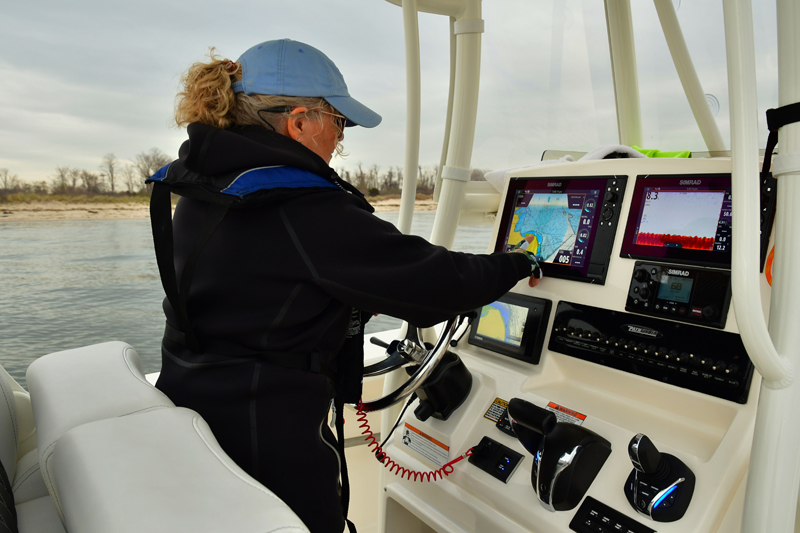
When we didn’t get a bite after a dozen casts using various lures, we easily moved the boat down the rockpile so we could cast to another section. To accomplish a lateral move, simply click the joystick in the desired direction. We preprogramed the system so each click would move the boat 10 feet in any direction. To move forty feet to the side, clicking the joystick four times “stacks” the increments. You can stack up to ten clicks if you want to move further. You can also move the boat forward or backward using the same joystick procedure, clicking the joystick to the front or the rear. If your boat has two or more outboards, Helm Master EX can move sideways, but the single engine system accomplishes the task by crabbing the boat forward and back until it settles on the new spot and automatically holds there without further input. You can also disengage FishPoint and move to the new position with the joystick or wheel and binnacle controls, then re-engage it to hold in the new spot. While the swells and current tried to move us off position, the Helm Master EX stayed on point beautifully.
So, what was the system doing to simplify this incredibly complex maneuver? When we activated the joystick, all outboard functions transfered to the computer. This included shifting, outboard RPM adjustment and steering. When we engaged FishPoint (bow), the system instantly established its current position through its proprietary GPS receiver. To determine the direction the boat pointed, the system coordinated the GPS system with the heading sensor. Then the computer began manipulating the outboard in response to any forces attempting to move the boat off position. As the effects of wind and current impacted the boat, the system shifted the engine in and out of gear as needed, accelerating or decelerating as much as necessary to counter those forces and steered the boat to maintain the desired location and direction. Now tell me that isn’t remarkable!
If you want to take control back from the computer, you can do so in several ways. You can press the FishPoint button again and then run the boat using normal joystick functionality. In manual joystick mode, pull back on the joystick to accelerate in reverse or push it toward the bow to accelerate forward. The more you push the joystick, the faster the boat accelerates. To turn the boat, spin the top of the joystick in the direction you want to turn. The more you turn the joystick, the harder the boat will turn. The joystick uses two finger operation to accomplish a lot of tasks. There is a speed limiter in joystick mode the operator can increase or decrease using the + or – button on the side of the joystick base.
You can return to manual control of the boat by pressing the joystick button to disengage it or if you’re in a hurry, you can simply use the shift and throttle lever and the system will turn off the joystick. Keep in mind that when the boat is in joystick mode and you are not using it, the engine returns to a neutral center position.
Running the boat with the joystick takes a little getting used to, but quickly becomes intuitive. Using automated functions like FishPoint requires almost no acclimation time. It’s still a good idea to practice various system functions before you are in an actual navigation or fishing situation, and it’s always incumbent upon the operator to be situationally aware of what is happening around the boat.
The system functions used in the lighthouse scenario translate into a number of additional classic fishing situations like approaching buoys, commercial fishing highfliers, or any kind of floating structure that might attract gamefish including cobia, mahi, tripletails or other fish. You can use FishPoint to hold position in a current when fishing near bridges over tidal waters with remarkable precision, or when working the tips of shoreline jetties. However, the system has so much more to offer.
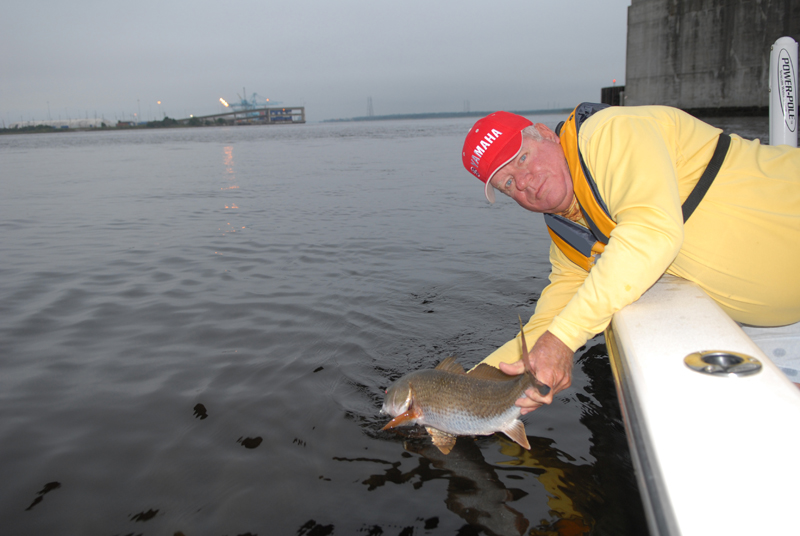
Not long ago we fished for redfish in the St. Johns River Inlet in Mayport, Florida. An extensive jetty system that extends hundreds of yards out from land protects the inlet. That rock breakwater is also a fish-attracting structure, both on the inside and outside of the inlet. At certain times of the year, the rocks become a highway for redfish and sea trout migrating in and out of the river. The ability to fish those jetties effectively can make for some fast fishing. Here’s how Helm Master EX can make that a reality. In this instance, we used the system’s autopilot combined with the Speed Control function to set and run a track along the length of the jetty so we could concentrate on casting to the structure instead of running the boat.
Helm Master EX interfaces with most brands of chart plotters, and Yamaha’s CL7 Multi-Functional Display is also a full-function chart plotter in addition to providing the outboard information and control unit. Using either the CL7 or your onboard chart plotter, you can set a series of waypoints using the touchscreen and save it as a trail. Once the trail is complete, activate the Yamaha autopilot pressing the TrackPoint button, then set the speed you want the boat to run using the Speed Control button on the throttle lever. Speed Control is the marine equivalent of the cruise control system on your road vehicle, but it can do some things your car’s system cannot. Once you set your initial speed, you can increase or decrease the speed setting with the rocker button on the binnacle lever. Once you’ve done that, the boat will run the track by itself at the speed you set and when it reaches the last waypoint, it will automatically shift into FishPoint and hold that position.
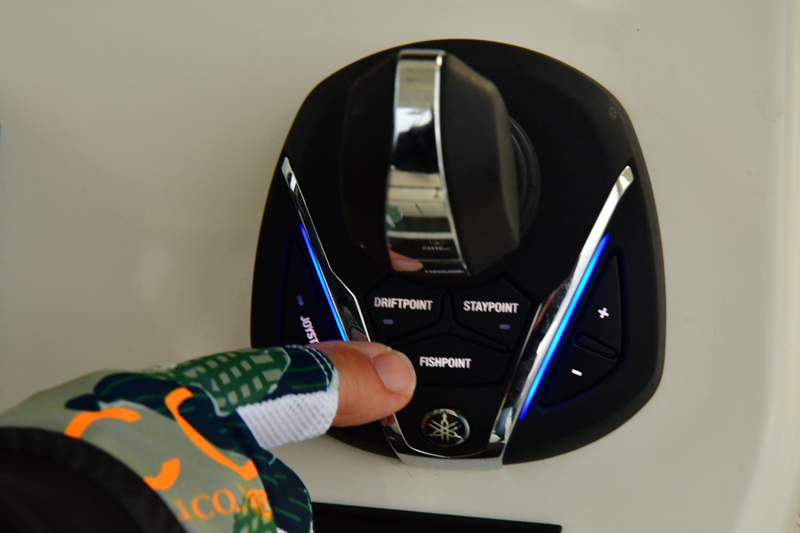
If you are casting, you’ll want to move slowly along the length of the jetty, allowing for appropriate bait or lure presentations. If the speed you desire is actually slower than the outboard running at idle speed, the system will enter Pattern Shift mode and the computer will bump the outboard in and out of gear to maintain that speed. It does this quietly, thanks to Yamaha’s exclusive shift dampening system (SDS) props and precision machined lower unit gearing. Speed Control is an incredibly useful feature that plays into many more types of fishing. Even if there is a running tide, wind or strong currents, the boat will maintain the speed you set by automatically adjusting the RPM of the outboard(s).
Now let’s translate the Mayport jetty scenario to some other similar situations. Imagine fishing along the shoreline of a bay or tidal river that might extend for a long distance. Or maybe you see fish holding along the edge of a channel drop off. By plotting a trail with as many waypoints as is necessary to keep the boat following the shoreline or underwater contours, TrackPoint and Speed Control will handle the boat while you fish. If there are spots you fish on a regular basis or might return to another day, you can save it as a trail and return to it without having to program it again. Spend a little time thinking about this one and you will likely come up with even more ways to incorporate it into your fishing.
Helm Master EX offers so many benefits for anglers that it is literally rewriting the playbook for how to use a boat as a fishing tool. We’ll be back with more tips and tricks for using Helm Master EX to get the most out of your time on the water in future installments.
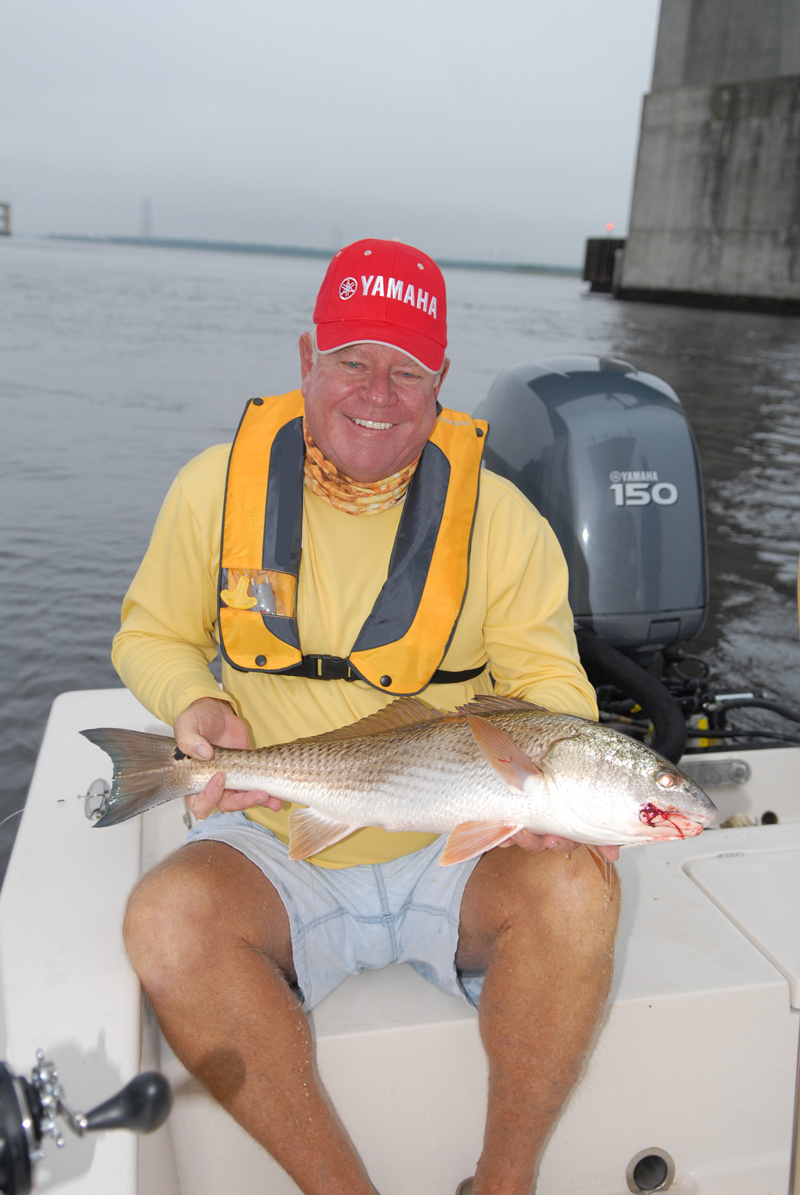
The events described detail the personal experiences of writer and angler Gary Caputi. All situations and system applications are different. For Helm Master EX peak performance, it is the responsibility of the captain to position the boat for the greatest chance of success given the conditions.
Back to Blue Life
Anglers on two other boats had the same idea, but the wind, waves and current hampered their ability to hold position near the rocks. They ran their boats close enough for a quick cast but were quickly swept away. Even when the operator tried to hold the boat in position for an angler to cast, their attempts were short lived. Conditions like these can make fishing good structure nearly impossible. We held back and watch the other boats make several attempts only to drift out of range almost as soon as they got into position. The frustration on the faces of the operators was evident, especially when we pulled into casting range and used our secret weapon—the Helm Master® EX system our Yamaha-powered Pathfinder® 2700 installed at the Maverick® Boat Group factory in Fort Pierce, Florida.

If you’re not familiar with Yamaha’s remarkable Helm Master EX system, you should be, especially if you’re thinking about a new boat or repowering an existing boat. It’s quite literally artificial intelligence for your boat, and a game changer for fishermen.
The complete Helm Master EX boat control system consists of electronic steering, shift and throttle binnacle, joystick, autopilot, GPS receiver, heading sensor, CPU and touchscreen multifunction display all interfaced into a seamless operating environment that offers an array of navigation and fishing benefits. It’s available for boats powered by single and multiple Yamaha outboards from the four-cylinder F150 to the eight-cylinder XTO® 425. In this installment of Fishing with Helm Master EX, we’ll look at some of the system’s capabilities that can come into play when fishing around structure and shorelines. Be prepared to be amazed.
Back to the lighthouse. When the other boats moved away, we ran the Pathfinder within casting distance of the rocks and hit the joystick button, which transfers helm control from the steering wheel and binnacle controls to the joystick and computer. With the push of a button on the joystick base, we activated the the FishPoint® function. FishPoint maintains the boat’s GPS position with either the bow or stern facing into the prevailing current or wind depending on how you set it up in the menu. We had it set for FishPoint Bow, so the forward casting platform would be closest to the structure. The system instantly took control of the electric steering-equipped F300 outboard so we could concentrate on fishing. The operators of the other boats watched from positions nearby in amazement as our outboard started to shift, adjust RPM and steer itself as if by magic holding our position while we made repeated casts into the white water. The look on their faces was akin to hearing them say, “Who’s running the boat?”

When we didn’t get a bite after a dozen casts using various lures, we easily moved the boat down the rockpile so we could cast to another section. To accomplish a lateral move, simply click the joystick in the desired direction. We preprogramed the system so each click would move the boat 10 feet in any direction. To move forty feet to the side, clicking the joystick four times “stacks” the increments. You can stack up to ten clicks if you want to move further. You can also move the boat forward or backward using the same joystick procedure, clicking the joystick to the front or the rear. If your boat has two or more outboards, Helm Master EX can move sideways, but the single engine system accomplishes the task by crabbing the boat forward and back until it settles on the new spot and automatically holds there without further input. You can also disengage FishPoint and move to the new position with the joystick or wheel and binnacle controls, then re-engage it to hold in the new spot. While the swells and current tried to move us off position, the Helm Master EX stayed on point beautifully.
So, what was the system doing to simplify this incredibly complex maneuver? When we activated the joystick, all outboard functions transfered to the computer. This included shifting, outboard RPM adjustment and steering. When we engaged FishPoint (bow), the system instantly established its current position through its proprietary GPS receiver. To determine the direction the boat pointed, the system coordinated the GPS system with the heading sensor. Then the computer began manipulating the outboard in response to any forces attempting to move the boat off position. As the effects of wind and current impacted the boat, the system shifted the engine in and out of gear as needed, accelerating or decelerating as much as necessary to counter those forces and steered the boat to maintain the desired location and direction. Now tell me that isn’t remarkable!
If you want to take control back from the computer, you can do so in several ways. You can press the FishPoint button again and then run the boat using normal joystick functionality. In manual joystick mode, pull back on the joystick to accelerate in reverse or push it toward the bow to accelerate forward. The more you push the joystick, the faster the boat accelerates. To turn the boat, spin the top of the joystick in the direction you want to turn. The more you turn the joystick, the harder the boat will turn. The joystick uses two finger operation to accomplish a lot of tasks. There is a speed limiter in joystick mode the operator can increase or decrease using the + or – button on the side of the joystick base.
You can return to manual control of the boat by pressing the joystick button to disengage it or if you’re in a hurry, you can simply use the shift and throttle lever and the system will turn off the joystick. Keep in mind that when the boat is in joystick mode and you are not using it, the engine returns to a neutral center position.
Running the boat with the joystick takes a little getting used to, but quickly becomes intuitive. Using automated functions like FishPoint requires almost no acclimation time. It’s still a good idea to practice various system functions before you are in an actual navigation or fishing situation, and it’s always incumbent upon the operator to be situationally aware of what is happening around the boat.
The system functions used in the lighthouse scenario translate into a number of additional classic fishing situations like approaching buoys, commercial fishing highfliers, or any kind of floating structure that might attract gamefish including cobia, mahi, tripletails or other fish. You can use FishPoint to hold position in a current when fishing near bridges over tidal waters with remarkable precision, or when working the tips of shoreline jetties. However, the system has so much more to offer.

Not long ago we fished for redfish in the St. Johns River Inlet in Mayport, Florida. An extensive jetty system that extends hundreds of yards out from land protects the inlet. That rock breakwater is also a fish-attracting structure, both on the inside and outside of the inlet. At certain times of the year, the rocks become a highway for redfish and sea trout migrating in and out of the river. The ability to fish those jetties effectively can make for some fast fishing. Here’s how Helm Master EX can make that a reality. In this instance, we used the system’s autopilot combined with the Speed Control function to set and run a track along the length of the jetty so we could concentrate on casting to the structure instead of running the boat.
Helm Master EX interfaces with most brands of chart plotters, and Yamaha’s CL7 Multi-Functional Display is also a full-function chart plotter in addition to providing the outboard information and control unit. Using either the CL7 or your onboard chart plotter, you can set a series of waypoints using the touchscreen and save it as a trail. Once the trail is complete, activate the Yamaha autopilot pressing the TrackPoint button, then set the speed you want the boat to run using the Speed Control button on the throttle lever. Speed Control is the marine equivalent of the cruise control system on your road vehicle, but it can do some things your car’s system cannot. Once you set your initial speed, you can increase or decrease the speed setting with the rocker button on the binnacle lever. Once you’ve done that, the boat will run the track by itself at the speed you set and when it reaches the last waypoint, it will automatically shift into FishPoint and hold that position.

If you are casting, you’ll want to move slowly along the length of the jetty, allowing for appropriate bait or lure presentations. If the speed you desire is actually slower than the outboard running at idle speed, the system will enter Pattern Shift mode and the computer will bump the outboard in and out of gear to maintain that speed. It does this quietly, thanks to Yamaha’s exclusive shift dampening system (SDS) props and precision machined lower unit gearing. Speed Control is an incredibly useful feature that plays into many more types of fishing. Even if there is a running tide, wind or strong currents, the boat will maintain the speed you set by automatically adjusting the RPM of the outboard(s).
Now let’s translate the Mayport jetty scenario to some other similar situations. Imagine fishing along the shoreline of a bay or tidal river that might extend for a long distance. Or maybe you see fish holding along the edge of a channel drop off. By plotting a trail with as many waypoints as is necessary to keep the boat following the shoreline or underwater contours, TrackPoint and Speed Control will handle the boat while you fish. If there are spots you fish on a regular basis or might return to another day, you can save it as a trail and return to it without having to program it again. Spend a little time thinking about this one and you will likely come up with even more ways to incorporate it into your fishing.
Helm Master EX offers so many benefits for anglers that it is literally rewriting the playbook for how to use a boat as a fishing tool. We’ll be back with more tips and tricks for using Helm Master EX to get the most out of your time on the water in future installments.

The events described detail the personal experiences of writer and angler Gary Caputi. All situations and system applications are different. For Helm Master EX peak performance, it is the responsibility of the captain to position the boat for the greatest chance of success given the conditions.
Back to Blue Life
